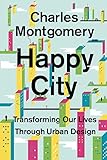Happy city transforming our lives through urban design Charles Montgomery
Tipo de material: TextoIdioma: Inglés Detalles de publicación: Nueva York Farrar, Straus and Giroux 2013Edición: 1a ediciónDescripción: 358 páginas ilustraciones, mapas, fotografías ; blanco y negro 21 cmISBN:
TextoIdioma: Inglés Detalles de publicación: Nueva York Farrar, Straus and Giroux 2013Edición: 1a ediciónDescripción: 358 páginas ilustraciones, mapas, fotografías ; blanco y negro 21 cmISBN: - 9780374168230 (Tapa dura)
- 9781429969536 (electrónico)
- 9780374534882
- 711.13 M657h 23
| Tipo de ítem | Biblioteca actual | Colección | Signatura topográfica | Copia número | Estado | Fecha de vencimiento | Código de barras | |
|---|---|---|---|---|---|---|---|---|
| Libro Colección General | Central Bogotá Sala General | Colección General | 711.13 M657h (Navegar estantería(Abre debajo)) | 1 | Disponible | 0000000139408 |
Incluye bibliografía (páginas 323-358).
1. The Mayor of Happy. -- 2. The City Has Always Been a Happiness Project. -- 3. The (Broken) Social Scene. -- 4. How We Got Here. -- 5. Getting It Wrong. -- 6. How to Be Closer. -- 7. Convivialities. -- 8. Mobilicities I: How Moving Feels, and Why It Does Not Feel Better. -- 9. Mobilicities II: Freedom. -- 10. Who Is the City For?. -- 11. Everything Is Connected to Everything Else. -- 12. Retrofitting Sprawl. -- 13. Save Your City, Save Yourself. - Epilogue: The Beginning. -- Notes. -- Acknowledgments.
Charles Montgomery's Happy City is revolutionizing the way we think about urban life. After decades of unchecked sprawl, more people than ever are moving back to the city. Dense urban living has been prescribed as a panacea for the environmental and resource crises of our time. But is it better or worse for our happiness? Are subways, sidewalks, and condo towers an improvement on the car dependence of the suburbs? The award-winning journalist Charles Montgomery finds answers to such questions at the intersection between urban design and the emerging science of happiness, during an exhilarating journey through some of the world's most dynamic cities. He meets the visionary mayor who introduced a "sexy" bus to ease status anxiety in Bogotá; the architect who brought the lessons of medieval Tuscan hill towns to modern-day New York City; the activist who turned Paris's urban freeways into beaches; and an army of American suburbanites who have hacked the design of their own streets and neighborhoods. Rich with new insights from psychology, neuroscience, and Montgomery's own urban experiments, Happy City reveals how cities can shape our thoughts as well as our behavior. The message is ultimately as surprising as it is hopeful: by retrofitting cities and our own lives for happiness, we can tackle the urgent challenges of our age. The happy city can save the world and we can all help build it.

